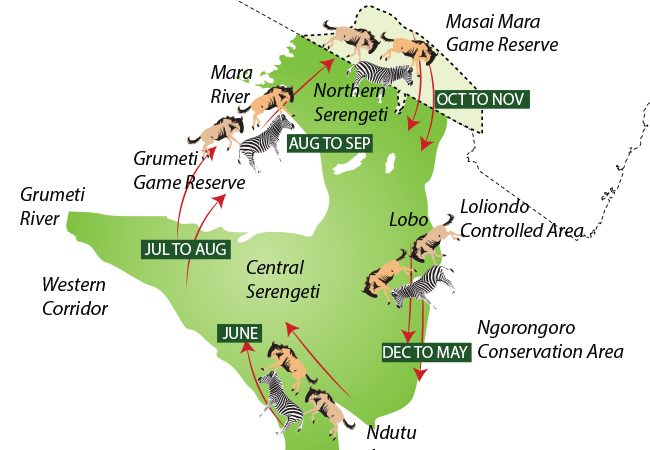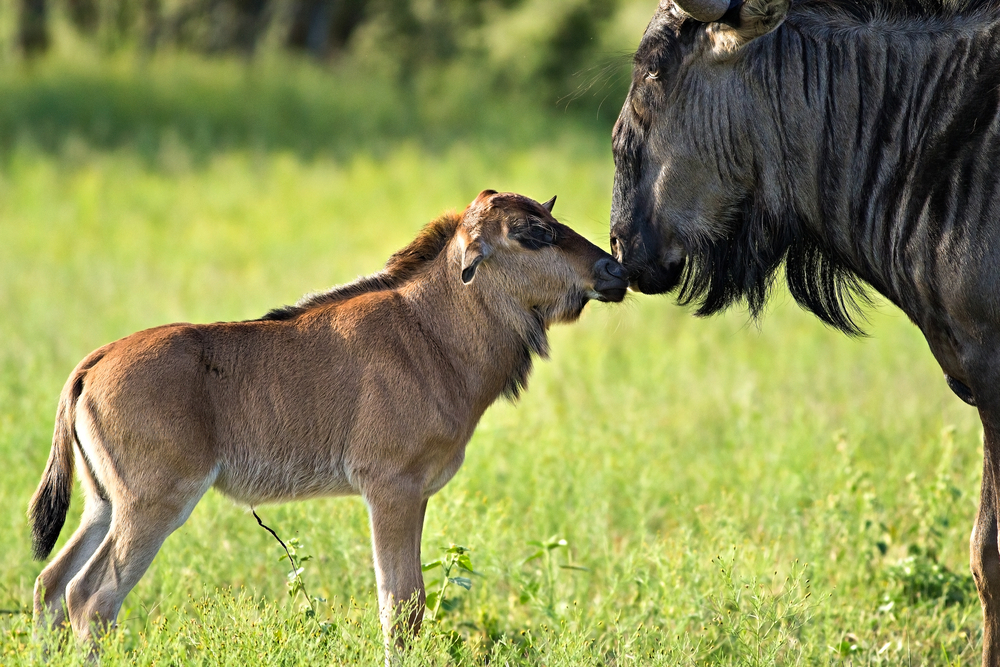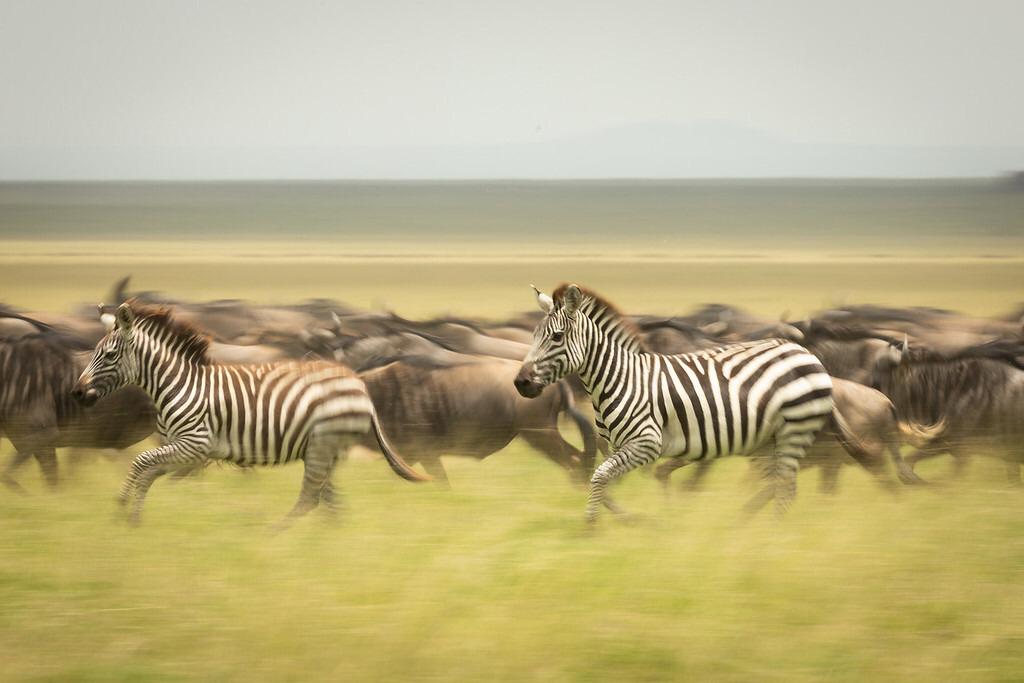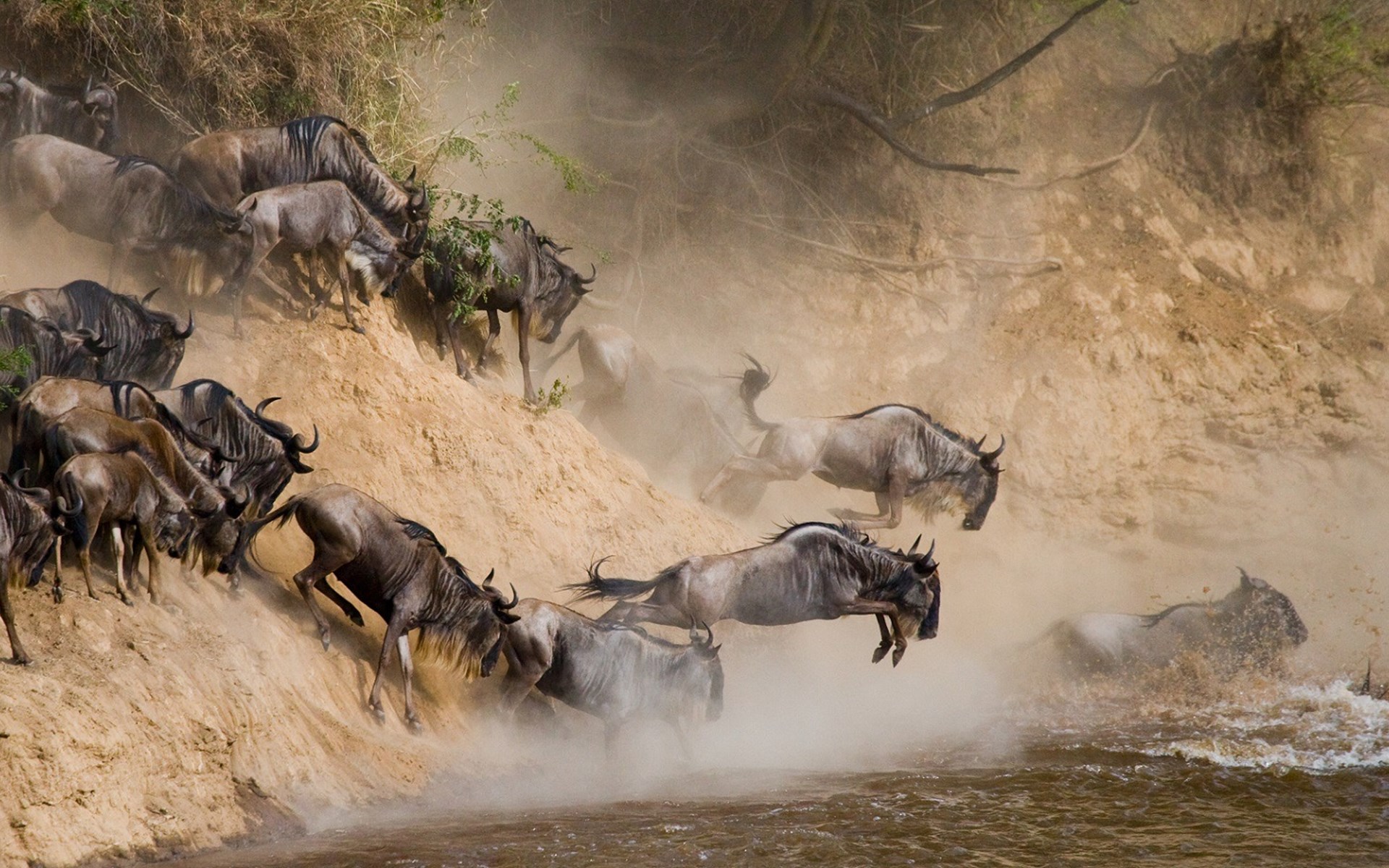Wildebeest Migration Routes
The humble leader of the migration is the Wildebeest, known to be lacking in intelligence, earning it the affectionate moniker ‘clown of the plains’. In its defense, the Wildebeest is a successful team player and as a gregarious herbivore it reaches up to 1.5 million in numbers as part of the migration. Its intelligence and ability to survive in such a harsh environment as the East African bush lies in its strength in numbers - a super-herd in the seemingly never-ending circle of life of the Serengeti.
Accompanied by 200,000 zebra, 350,000 gazelles and 12,000 eland this strange wonder of the natural world circulates the Serengeti National Park in Tanzania and the Masai Mara Game Reserve in Kenya, its path dictated by rainfall and the resulting growth of grasses on the plains. There is neither a start nor finish to their journey; merely a relentless sequence of life and death. The only beginning is the moment of birth and the only ending is death - which can come only too easily in the migration.
The precise timing of the migration is entirely dependent upon the rainfall patterns each year. Nor is it confined to the un-fenced National Park, and instead seamlessly flows into the surrounding Game Reserves. Between January and March the Ngorongoro Conservation Area and Maswa Game Reserve, south-east of the Serengeti offer refuge during what is the short dry season thanks to its numerous rivers and spring grasses, allowing an opportunity for the Wildebeest to rest and give birth. Up to 400,000 calves are born in a synchronized birthing within just two to three weeks of one another! Unsurprisingly, this period presents a veritable feast for any accompanying predators - and the first challenge in the wildebeest’s life - with hundreds of hyenas and lions scattered across this area taking their chances with a potential glut of vulnerable newborns.
From here the migration heads north again, through the park and towards the Kenyan border where it will arrive by July. It is from this point that the migration takes on one of its most spectacular and deadly advances: - the river crossings; in the Serengeti the Mbalangeti and Grumeti rivers, and in Kenya, the most famous crossing; the Mara river. For most of the year these rivers are relatively placid and often dry, but come the rains they become violent torrents presenting major obstacles to the progress of the wildebeest.
The wildebeest will instinctively start heading south again, trekking down through the eastern woodlands and back into the Ngorongoro Conservation Area. The Wildebeest scatter and spread out again once they reach the open plains having completed a journey of over 500 miles. With 90 per cent of the cows heavy with the new season’s young the journey is ready to start once again with the birth of the next generation of calves.
For any visitor to the Serengeti, the wildlife spectacle of the migration offers a huge enhancement to what is already an overwhelming sight. Many of the lodges and safari camps are located in great positions for the arrival of the migration in their area and throughout the park numerous migrations mobile camps pop-up in time for the arrival of the herd. Tanzania is the place to be for this natural wonder. And should you be unable to visit the location of the migration during your visit, don’t worry; life still goes on throughout the park, with smaller groups of wildebeest, zebra and gazelles remaining resident in the more fertile areas of the park throughout the year; the lazy or the clever ones? We’ll let you decide!
What is the Serengeti Wildebeest Migration?

Each year, over 1.5 million wildebeest, zebras, gazelles & impalas gather up their young and embark on an epic journey from the southern Serengeti in Tanzania to the Masai Mara in Kenya in search of greener pastures. The unique opportunity to be a part of this massive adventure on private safari is the ultimate goal for African Safari lovers; perfect for novice or experienced travelers. Depending on the time of year, there are ideal locations in the Serengeti and Masai Mara to embark upon the experience of a lifetime and witness the wildebeest migration. See below for a guide to monthly Serengeti Wildebeest Migration patterns, what to expect on a safari holiday, and the best safari lodges to make the most of your holiday.
January, February & March
The majority of wildebeest calves are born here in February, with around half a million new calves in the Serengeti that month. As the Southern plains become picked over, the herds begin to spread west and prepare for their migration north in the spring. An easy kill isn’t always guaranteed as the female wildebeest instinctively head to the short grass plains so that they can see predators approaching and they form a barricade around birthing mothers to protect them and their young, ensuring the majority of the newborn calves survive.
Towards the end of the short dry season (usually end of March), the short-grass plains of the southern Serengeti begin to dry out and the wildebeest and zebra start to head towards the western woodlands.


April & May
By April the Wildebeest begin their journey, moving in en-mass, head to tail, northwards into the National Park and passing through the popular central area of the park at Seronera. This is also the time of the annual rut, and start of the gestation period (eight and a half months) of the next year’s calves. In May the Rainy season arrives and brings heavy precipitation to the west of the park. Shortly after this the fertile plains bear a heavy cover of grass drawing the migration westward towards it. The Western Corridor including the Grumeti Game Reserve and Ikorongo Game Reserve host the majority of the migration through June, offering the Game a chance to build up their strength for the journey ahead.
June, July & August
The rutting season (mating season) usually starts in June, and you can expect to see fierce fighting between competitive males as they vie for the attention of females. July the herds head north . To get there they must face one of the greatest obstacles of their journey – crossing the Grumeti River. The dramatic river crossings, one of the most exciting events of the Great Migration, usually start in July, but the precise timing depends on the rains. The wildebeest and zebra grow into a ‘mega-herd’ before attempting to cross the Grumeti River to continue their journey north. With treacherous water currents and Nile crocodiles are lurking in the muddy waters and lions, cheetahs, leopards and hyenas waiting on the river banks, only the strongest survive.

September & October
The eye of the migration moves to Kenya and the Masai Mara while the beasts go in search of fresh grass to graze. This is a wonderful time to be on safari in the Masai Mara. As the rains begin in October, the herds begin their long journey South back to the Serengeti following the new grass. Of course; this doesn’t mean that life becomes easy, as danger still lurks in the form of hunting prides of lion and packs of hyena.
November & December
The short rains start in Tanzania at the end of October or early November, drawing the wildebeest and zebra back to the plains of the southern Serengeti which are green and lush once more. The bulk of the herd arrives back in the Serengeti for the rainy season. The Wildebeest may begin to give birth and prepare to complete the cycle over again next year!

